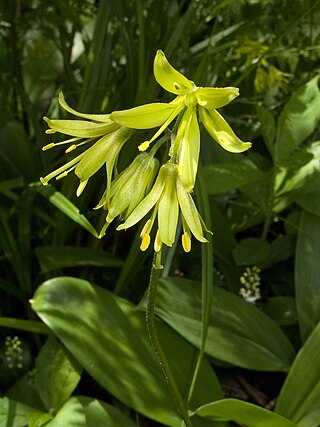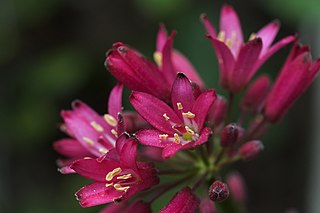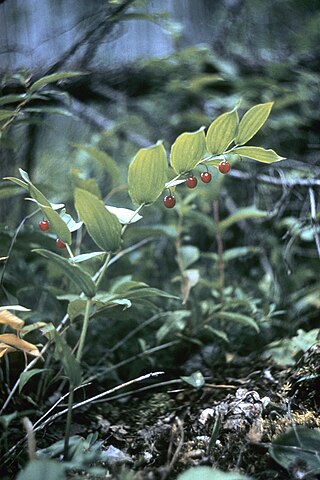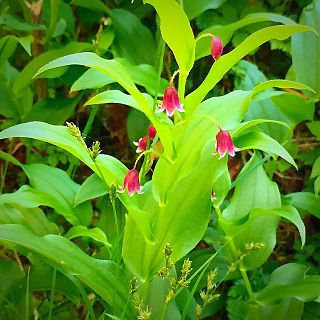
Trillium is a genus of about fifty flowering plant species in the family Melanthiaceae. Trillium species are native to temperate regions of North America and Asia, with the greatest diversity of species found in the southern Appalachian Mountains in the southeastern United States.

Erythronium, the fawn lily, trout lily, dog's-tooth violet or adder's tongue, is a genus of Eurasian and North American plants in the lily family, most closely related to tulips. The name Erythronium derives from Ancient Greek ἐρυθρός (eruthrós) "red" in Greek, referring to the red flowers of E. dens-canis. Of all the established species, most live in North America; only six species are found in Europe and Asia.

The flowering plant genus Ipheion belongs to Allioideae, a subfamily of the family Amaryllidaceae. It includes three species native to southern Brazil, northeastern Argentina, and Uruguay.

Clintonia borealis is a species of flowering plant in the lily family Liliaceae. The specific epithet borealis means "of the north," which alludes to the fact that the species tends to thrive in the boreal forests of eastern Canada and northeastern United States.

Eriophorum is a genus of flowering plants in the family Cyperaceae, the sedge family. They are found in the cool temperate, alpine, and Arctic regions of the Northern Hemisphere, primarily in the middle latitudes of North America, Europe, and Asia.

Uvularia is a genus of flowering plants in the family Colchicaceae, which is closely related to the lily family (Liliaceae). They are commonly called bellworts, bellflowers, or merrybells. The genus name is derived from the Latin ūvula meaning "little grape", likely because of the way the flowers hang downward. For the same reason Uvularia may also refer to the similarly derived palatine uvula, which hangs down from the soft palate in the mouth. The plants are often found growing on wooded slopes or in ravines and they spread by stolons, or stoloniferous rhizomes. The plants are usually 45–60 cm (18–24 in) in height and bear one or two flowers per stem in April and May, that hang downward from the axils of the leaves.

Melica is a genus of perennial grasses known generally as melic or melic grass. They are found in most temperate regions of the world.

Clintonia uniflora, commonly known as bride's bonnet, queen's cup, or bead lily, is a species of flowering plant in the lily family Liliaceae. The specific epithet uniflora means "one-flowered", a characteristic that distinguishes this species from others in the genus Clintonia. For this reason, it is also known as the single-flowered clintonia.

Orbexilum, commonly called leather-root, is a genus of flowering plants in the legume family (Fabaceae). They are native to North America, where they are found in the United States and Mexico, south to Chiapas.

Clintonia andrewsiana is a species of flowering plant in the lily family Liliaceae. The species was discovered by John Milton Bigelow in 1854 and described by John Torrey in 1856. The specific epithet andrewsiana honors Timothy Langdon Andrews (1819–1908), a "gentleman who assiduously examined the botany" of California during the mid-19th century. The species is commonly known as Andrews clintonia or red clintonia, where the latter refers to the color of the flowers. In California, it is also known as bluebead lily or western bluebead lily, not to be confused with C. borealis, which is likewise known as bluebead lily. The Pomo people of northern California consider the plant to be poisonous.

Suaeda nigra, often still known by the former name Suaeda moquinii, is a species of flowering plant in the amaranth family, known by the vernacular names bush seepweed or Mojave sea-blite.

Clintonia umbellulata, commonly known as white clintonia or speckled wood-lily, is a species of flowering plant in the lily family Liliaceae. The specific epithet umbellulata means "umbelled," which refers to the shape of the plant’s inflorescence.

Streptopus lanceolatus, is an understory perennial plant native to the forests of North America, from Alaska to Labrador, south through the Great Lakes and Appalachian Mountain regions of the United States, as well as Montana, Washington state, Oregon, and St. Pierre & Miquelon. It grows primarily in mixed-wood forests, and throughout a wide range of soil and site conditions, preferring cool, acidic soils.

Streptopus is a Eurasian and North American genus of flowering plants in the lily family, found primarily in colder and temperate regions. Members of the genus are often referred to as twistedstalk. It is one of the shade-loving genera of the lily family.

Medeola virginiana, known as Indian cucumber, cucumber root, or Indian cucumber-root, is an eastern North American plant species in the lily family, Liliaceae. It is the only currently recognized plant species in the genus Medeola. It grows in the understory of forests. The plant bears edible rhizomes that have a mild cucumber-like flavor.

Clintonia udensis is a species of flowering plant in the lily family Liliaceae. It is the only species of Clintonia native to Asia. It prefers sparsely forested habitat including the alpine forests of the Himalayas.
Bead lily is a common name for several flowering plant species in genus Clintonia, including:

Ilex umbellulata is an evergreen tree species related to holly, generally four to fifteen metres in height. It is found in Southeast Asia. This tree is most often found growing in forests.






















